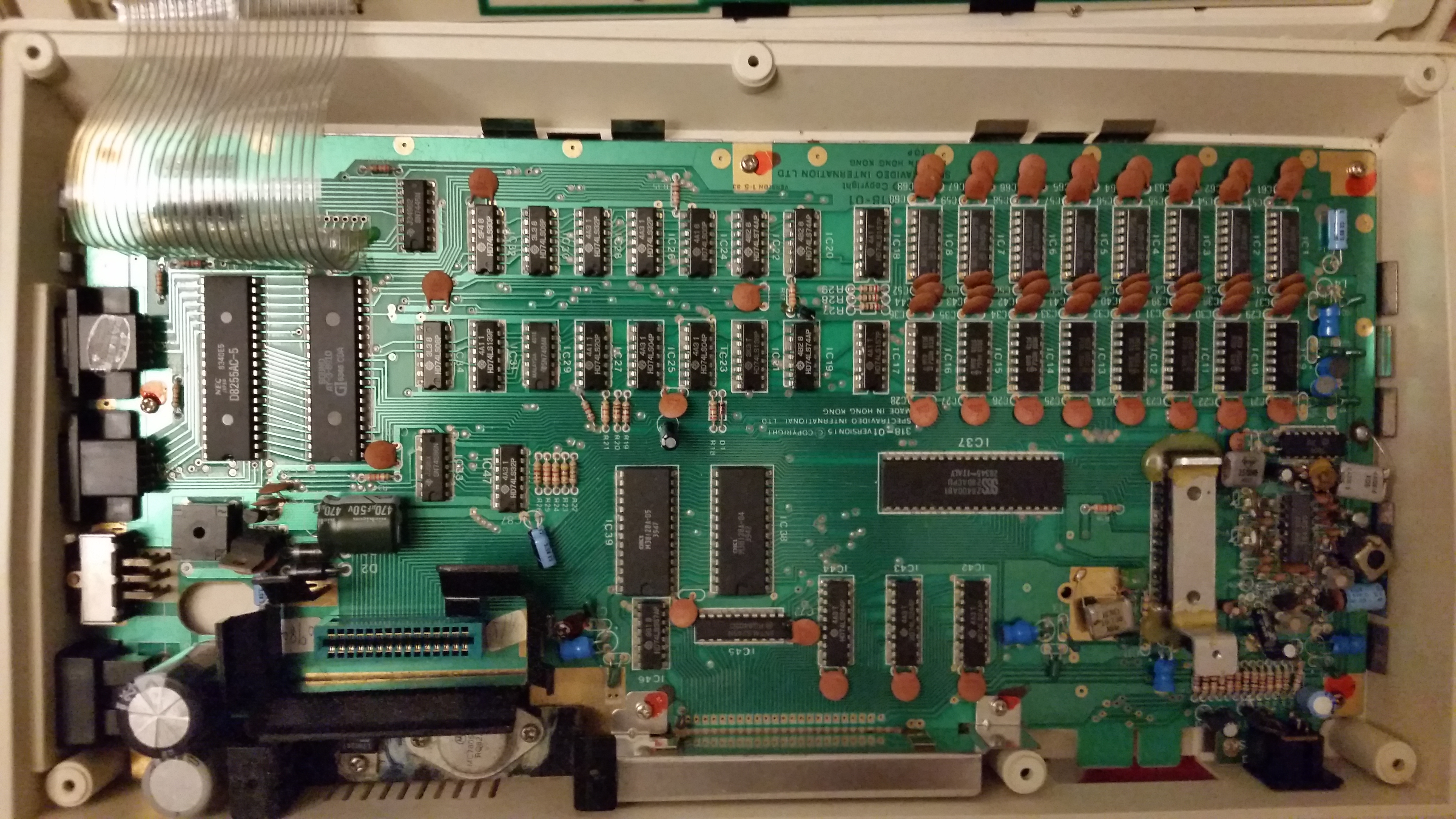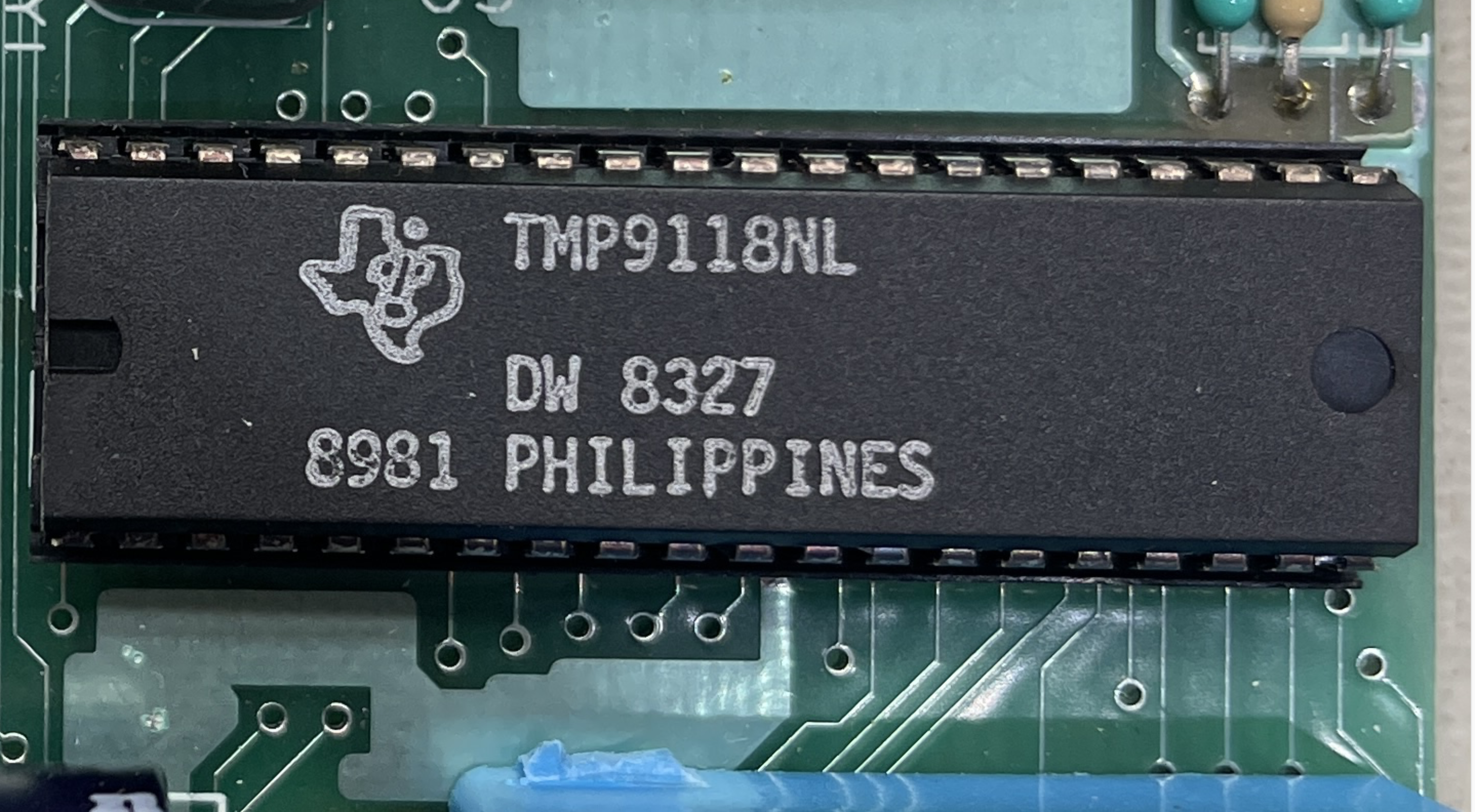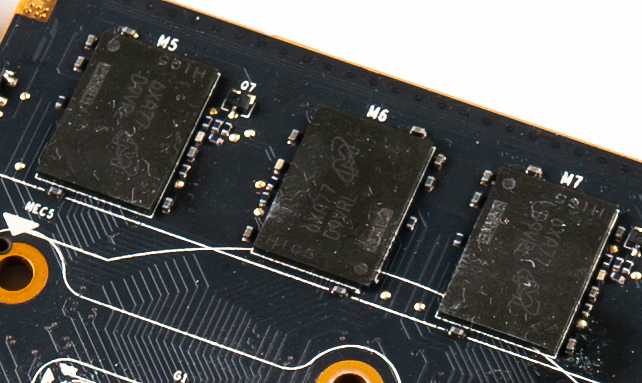|
SV-328
The SV-328 is an 8-bit home computer introduced by Spectravideo in June 1983. It was the business-targeted model of the Spectravideo range, sporting a compact full-travel keyboard with numeric keypad. It had 80 KB Random-access memory, RAM (64 KB available for software, remaining 16 KB video memory), a respectable amount for its time. Other than the keyboard and RAM, this machine was identical to its little brother, the SV-318. The SV-328 is the design on which the MSX standard was based. Spectravideo's MSX-compliant successor to the 328, the SV-728, looks almost identical, the only immediately noticeable differences being a larger cartridge slot in the central position (to fit MSX standard cartridges), lighter shaded keyboard and the MSX badging. Reference to the operating system Microsoft BASIC, Microsoft Extended BASIC is not to be confused with MSX BASIC, although some marketing at the time claimed that Microsoft Extended is what MSX stood for. More than 130 ga ... [...More Info...] [...Related Items...] OR: [Wikipedia] [Google] [Baidu] |
Spectravideo
Spectravideo International Limited (SVI) (printed as Spectra Video, with the space, in game manuals) was an American computer manufacturer and software house. It was originally called SpectraVision, a company founded by Harry Fox in 1981. The company produced video games and other software for the VIC-20 home computer, the Atari 2600 home video game console, and its CompuMate peripheral. Some of their own computers were compatible with the Microsoft MSX or the IBM PC. Despite their initial success, the company faced financial troubles, and by 1988, operations ceased. Later, a UK-based company bought the Spectravideo brand name from Bondwell in 1988, but this company, known as Logic3, had no connection to the original Spectravideo products and was dissolved in 2016. History SpectraVision was founded in 1981 by Harry Fox and Alex Weiss as a distributor of computer games, contracting external developers to write the software. Their main products were gaming cartridges fo ... [...More Info...] [...Related Items...] OR: [Wikipedia] [Google] [Baidu] |
SV-318
The SV-318 is the basic model of the Spectravideo range. It was fitted with a chiclet style keyboard, which was difficult to use, alongside a combination cursor pad/joystick. This is a disc-shaped affair with a hole in the centre; put a red plastic 'stick' in the hole and with a built-in joystick, remove the stick and it is a directional arrow pad for word processing etc. This machine also had only 16 KB of user RAM (plus an additional 16 KB of video RAM), which limited its usefulness. However, this could be expanded via an external peripheral box. This machine is basically identical to its big brother the SV-328, the only differences being in the keyboard and amount of memory. The two machine's ROM, expandability, mainboard and case were identical. Reference to the operating system Microsoft Extended BASIC is not to be confused with MSX BASIC, although some marketing at the time claimed that Microsoft Extended is what MSX stood for. The SV-318 is not fully complian ... [...More Info...] [...Related Items...] OR: [Wikipedia] [Google] [Baidu] |
SV-728
The SVI-728 is the first home computer from Spectravideo that complied fully with the MSX home computer specification. It was introduced in 1984. The design is virtually identical to that of the earlier SV-328, which did not comply fully with the MSX standard. The SVI-738 is a portable version of this computer. Technical specifications The SVI-728 had the following technical specifications: ;Microprocessor * Zilog Z80A with a clockspeed of 3.58 MHz. ;Memory *ROM: 32 KB *RAM: 64 KB (expandable to 256 KB) *VRAM: 16 KB ;Video * Graphical processor: Texas Instruments TMS9918A/ TMS9929 (NTSC/PAL) :* Graphical resolution: 256 x 192 pixels :*text modes: 40 characters x 24 lines and 32 characters x 24 lines :*colors: 16 :*sprites: 32 ;Sound *General Instrument AY-3-8910-soundchip :*3 sound channels :*1 noise channels :*1 envelope controller ;Connectors *1 data recorder/Cassette deck *2 joystick A joystick, sometimes called a flight stick, is an input device consisting of a ... [...More Info...] [...Related Items...] OR: [Wikipedia] [Google] [Baidu] |
Microsoft BASIC
Microsoft BASIC is the foundation software product of the Microsoft company and evolved into a line of BASIC interpreters and compiler(s) adapted for many different microcomputers. It first appeared in 1975 as Altair BASIC, which was the first version of BASIC published by Microsoft as well as the first high-level programming language available for the Altair 8800 microcomputer. During the home computer craze of the late-1970s and early-1980s, Microsoft BASIC was ported to and supplied with many home computer designs. Slight variations to add support for machine-specific functions, especially graphics, led to a profusion of related designs like Commodore BASIC and Atari Microsoft BASIC. As the early home computers gave way to newer designs like the IBM Personal Computer and Macintosh, BASIC was no longer as widely used, although it retained a strong following. The release of Visual Basic rebooted its popularity and it remains in wide use on Microsoft Windows platforms in its m ... [...More Info...] [...Related Items...] OR: [Wikipedia] [Google] [Baidu] |
TMS9918
IMAGE:TMS9918A 01.jpg, VDP TMS9918A IMAGE:TMS9918A 02.jpg, VDP TMS9918A The TMS9918 is a video display controller (VDC) manufactured by Texas Instruments, in manuals referenced as "Video Display Processor" (VDP) and introduced in 1979. The TMS9918 and its variants were used in the PV-2000, Casio PV-2000, Coleco Adam, ColecoVision, VTech CreatiVision, CreatiVision, Hanimex, Hanimex Pencil II, MSX, Memotech MTX, NABU Network#Hardware, NABU Personal Computer, Programa Educativo de Colegios Secundarios, PECOS, SG-1000, SC-3000, SV-318, SV-328, Sord M5, TI-99/4A, TI-99/4, Tatung Einstein, and Tomy Tutor. The TMS9918 generates both grid-based character graphics (used to display text or background images) and sprite (computer graphics), sprites used for moving foreground objects. The key features of this chip are, as highlighted in a 1980 presentation by Karl Guttag (one of the designers): *256 by 192 full color pixels per screen *15 different colors and/or shades *Progressive scan, Non ... [...More Info...] [...Related Items...] OR: [Wikipedia] [Google] [Baidu] |
Numeric Keypad
A numeric keypad, number pad, numpad, or ten key, is the calculator-style group of ten numeric keys accompanied by other keys, usually on the far right side of computer keyboard. This grouping allows quick number entry with right hand, without the need to use both hands on number row of main keyboard. On a standard IBM PC keyboard, numpad has 17 keys, including digits to , (addition), (subtraction), (multiplication), and (Division (mathematics), division) symbols, (decimal point), , and keys. On smaller keyboards (such as those found on Laptop, laptops), the numeric keypad can be implemented as alternative markings on alphabetic keys (usually --, --, --) or added as a separate unit, that can be connected to a device by means such as USB; some of these may include keys not found on a standard numpad, such as a spacebar or a (or ) key. Sometimes it is necessary to distinguish between a key on the numpad and an equivalent key elsewhere on the keyboard. For example, ... [...More Info...] [...Related Items...] OR: [Wikipedia] [Google] [Baidu] |
Random-access Memory
Random-access memory (RAM; ) is a form of Computer memory, electronic computer memory that can be read and changed in any order, typically used to store working Data (computing), data and machine code. A random-access memory device allows data items to be read (computer), read or written in almost the same amount of time irrespective of the physical location of data inside the memory, in contrast with other direct-access data storage media (such as hard disks and Magnetic tape data storage, magnetic tape), where the time required to read and write data items varies significantly depending on their physical locations on the recording medium, due to mechanical limitations such as media rotation speeds and arm movement. In today's technology, random-access memory takes the form of integrated circuit (IC) chips with MOSFET, MOS (metal–oxide–semiconductor) Memory cell (computing), memory cells. RAM is normally associated with Volatile memory, volatile types of memory where s ... [...More Info...] [...Related Items...] OR: [Wikipedia] [Google] [Baidu] |
Software
Software consists of computer programs that instruct the Execution (computing), execution of a computer. Software also includes design documents and specifications. The history of software is closely tied to the development of digital computers in the mid-20th century. Early programs were written in the machine language specific to the hardware. The introduction of high-level programming languages in 1958 allowed for more human-readable instructions, making software development easier and more portable across different computer architectures. Software in a programming language is run through a compiler or Interpreter (computing), interpreter to execution (computing), execute on the architecture's hardware. Over time, software has become complex, owing to developments in Computer network, networking, operating systems, and databases. Software can generally be categorized into two main types: # operating systems, which manage hardware resources and provide services for applicat ... [...More Info...] [...Related Items...] OR: [Wikipedia] [Google] [Baidu] |
MSX BASIC
MSX BASIC is a dialect of the BASIC programming language. It is an extended version of Microsoft's MBASIC Version 4.5, adding support for graphic, music, and various peripherals attached to MSX microcomputers. Generally, MSX BASIC is designed to follow GW-BASIC, released the same year for IBM PCs and clones. During the creation of MSX BASIC, effort was made to make the system flexible and expandable. Distribution MSX BASIC came bundled in the Read-only memory, ROM of all MSX computers. At system start-up MSX BASIC is invoked, causing its command prompt to be displayed, unless other software placed in Read-only memory, ROM takes control (which is the typical case of ROM cartridge, game cartridges and disk interfaces, the latter causing the MSX-DOS prompt to be shown if there is a disk present which contains the DOS system files). When MSX BASIC is invoked, the ROM code for BIOS and the BASIC interpreter itself are visible on the lower 32K of the Zilog Z80, Z80 addressing space. ... [...More Info...] [...Related Items...] OR: [Wikipedia] [Google] [Baidu] |
Video Memory
Video random-access memory (VRAM) is dedicated computer memory used to store the pixels and other graphics data as a framebuffer to be rendered on a computer monitor. It often uses a different technology than other computer memory, in order to be read quickly for display on a screen. Relation to GPUs Many modern GPUs rely on VRAM. In contrast, a GPU that does ''not'' use VRAM, and relies instead on system RAM, is said to have a unified memory architecture, or shared graphics memory. System RAM and VRAM have been segregated due to the bandwidth requirements of GPUs, and to achieve lower latency, since VRAM is physically closer to the GPU die. Modern VRAM is typically found in a BGA package soldered onto a graphics card. The VRAM is cooled along with the GPU by the GPU heatsink. Technologies * Dual-ported video RAM, used in the 1990s and at the time often called "VRAM" * SGRAM * GDDR SDRAM * High Bandwidth Memory (HBM) See also * Graphics processing unit * Tiled render ... [...More Info...] [...Related Items...] OR: [Wikipedia] [Google] [Baidu] |
8-bit
In computer architecture, 8-bit integers or other data units are those that are 8 bits wide (1 octet). Also, 8-bit central processing unit (CPU) and arithmetic logic unit (ALU) architectures are those that are based on registers or data buses of that size. Memory addresses (and thus address buses) for 8-bit CPUs are generally larger than 8-bit, usually 16-bit. 8-bit microcomputers are microcomputers that use 8-bit microprocessors. The term '8-bit' is also applied to the character sets that could be used on computers with 8-bit bytes, the best known being various forms of extended ASCII, including the ISO/IEC 8859 series of national character sets especially Latin 1 for English and Western European languages. The IBM System/360 introduced byte-addressable memory with 8-bit bytes, as opposed to bit-addressable or decimal digit-addressable or word-addressable memory, although its general-purpose registers were 32 bits wide, and addresses were contained in the lower 24 bits ... [...More Info...] [...Related Items...] OR: [Wikipedia] [Google] [Baidu] |








